| Type | Battleship | Hull | Steel |
| Displacement | 10,060 tonnes | Engines | 2 triple expansion 3cyl, 10.110ihp, Kaiserliche Werft |
| Length | 115.7 m | Machinery | Steam turbine, 2 shafts |
| Beam | 19.5 m | Speed | 10 kts |
| Draught | 7.6 m | Complement | 600 |
| Armament | 4x280mm L/40 K, 2x280mm L/35 K, 6x105mm L/35 QF K, 6x88mm L/30 QF K, 12xMG, 3xTT 450mm SK | ||
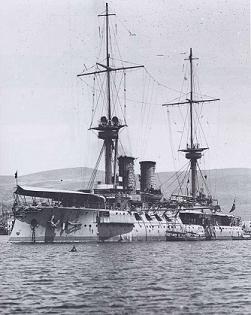
The story of Barbaros Hayreddin began with its construction in Germany in late 19th century. SMS Kurfürst Friedrich Wilhelm was laid down at the Imperial Shipyard in Wilhelmshaven in 1890 and launched on 30 June 1891. It was commissioned on 29 April 1894, as the third ship of its class. Named after the Elector Friedrich Wilhelm, who founded the first Brandenburg fleet, the ship played a significant role in various naval operations.
The battleship was involved in numerous maneuvers and foreign voyages, including visits to Sweden, Norway, and the Netherlands, as well as participation in naval parades and ceremonies. In 1899, it was designated as a battleship under the German Fleet Law and underwent further modifications to enhance its armament and capabilities.
In 1900, amidst the Boxer Rebellion in China, Kurfürst Friedrich Wilhelm was dispatched to East Asia along with other German warships to protect German interests and support the international coalition against the Boxers. The ship participated in blockading Chinese ports and supporting allied forces during the conflict. Following its return from East Asia in 1901, Kurfürst Friedrich Wilhelm underwent additional modifications and continued to serve in the German Navy for training purposes until 1907, when it was relegated to reserve duty due to obsolescence.
On 12 September 1910, the ship was officially sold to the Ottoman Empire for 9 million marks. This marked a significant milestone in the naval history of the Ottoman Empire, as it sought to modernize its fleet to compete with other major powers in the region. Following the sale, the ship was renamed Barbaros Hayreddin after the prominent Ottoman naval commander known for his leadership during the 16th century, particularly as the chief admiral of the Ottoman fleet and for his successful campaigns against European powers.
The renaming of the ship reflected the Ottoman Empire's desire to instill a sense of national pride and historical significance in its naval forces. Barbaros Hayreddin, along with its sister ship Turgut Reis (formerly SMS Weissenburg in the German Imperial Navy), became integral components of the Ottoman Navy, symbolizing the empire's aspirations for maritime dominance in the region.
During the First Balkan War in 1912, Barbaros Hayreddin played a significant role in several key naval engagements. On 17 November 1912, the ship, along with the old battleship Mesudiye, bombarded Bulgarian troops near Turkish positions near Çatalca. Although the targets were limited, the attack had a notable morale effect.
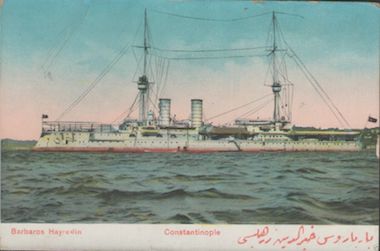
A month later, on 16 December, the Ottoman Navy made a daring attempt to break out of the Dardanelles with a fleet consisting of Barbaros Hayreddin, Turgut Reis, Mesudiye, the cruiser Mecidiye, and three destroyers, under the command of the acting fleet commander Colonel Ramiz Bey. Their objective was to engage in naval warfare in the Aegean. However, their efforts were thwarted by the Greek armoured cruiser Georgios Averoff and accompanying destroyers, resulting in casualties and damage to the Ottoman fleet in what came to be known as the Battle of Elli. Barbaros Hayreddin sustained significant hits, with casualties reported on board.
Undeterred, the Ottoman Navy made a second attempt to break out of the Dardanelles on 18 January 1913, in the Battle of Lemnos. The fleet, which this time included two more destroyers in addition to the shi,pts that saw action the month before, encountered fierce resistance from the Greek squadron under Rear Admiral Koundouriotis. The engagement resulted in heavy casualties and damage to the Ottoman fleet, particularly Barbaros Hayreddin, which sustained numerous hits and suffered significant losses among its crew.
In February 1913, Barbaros Hayreddin was involved in supporting an amphibious assault on Şarköy, near Tekirdağ, where Bulgarian troops had made advances in December. Despite the unsuccessful outcome of the attack, Barbaros Hayreddin provided crucial gunfire support to cover the retreat of Ottoman ground forces.
Returning to the Black Sea in March 1913, Barbaros Hayreddin once again engaged Bulgarian forces near Çatalca. On 26 and 30 March, the ship halted Bulgarian advances with its heavy and medium artillery, supporting Turkish efforts on the front lines.
The outbreak of the First World War in 1914 further intensified the challenges faced by the Ottoman Empire and its naval forces. At the time when hostilities commenced in Europe, Barbaros Hayreddin was undergoing refurbishment in Istanbul as it was found to be in poor condition by German engineers. As tensions escalated, repairs were postponed, and the ship was only loaded with ammunition and supplies.
During the early stages of the war, Barbaros Hayreddin played a role in supporting Ottoman defences in the Dardanelles, providing artillery support and coastal defence capabilities. Some of her guns were removed and used as coastal defences, while the ship served as a floating artillery battery at the Nara naval base alongside its sister ship, Turgut Reis. On 25 April 1915, both ships bombarded British landings during the Gallipoli Campaign, but Barbaros Hayreddin suffered damage to one of its gun barrels. Withdrawn in early June after further damage, she was dispatched on 7 August 1915, to support Ottoman defenses and resupply the Fifth Army. However, it was intercepted and torpedoed by the British submarine E11, resulting in her sinking near Bolayır at the northern end of the Gallipoli Peninsula. The attack led to the loss of 253 lives and marked the tragic end of Barbaros Hayreddin's illustrious naval career.
![]()
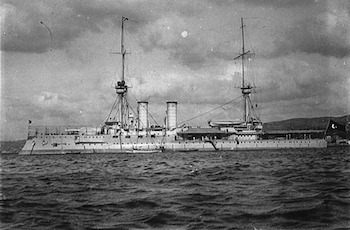
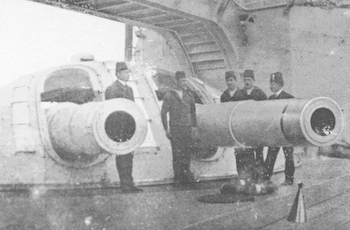
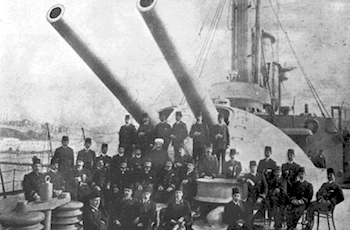
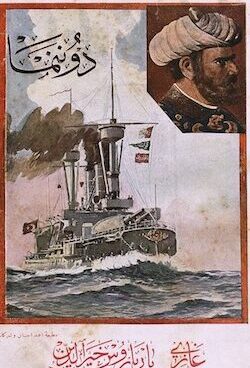
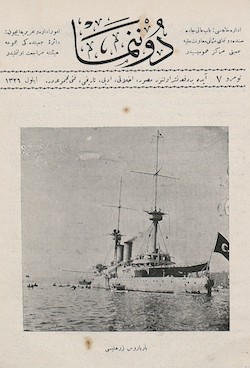
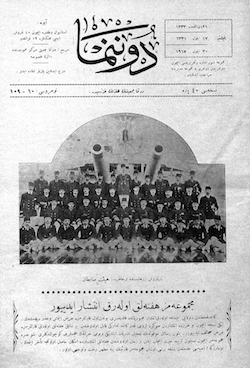
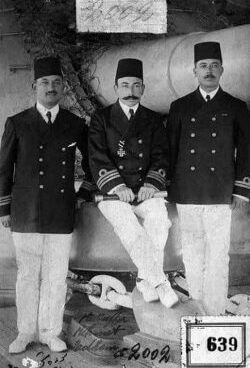
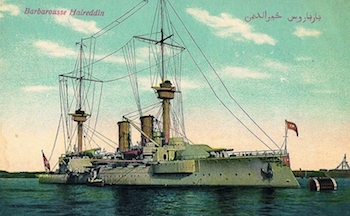
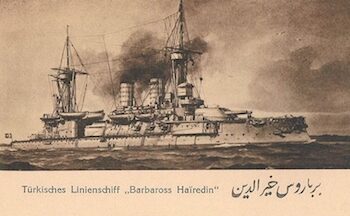
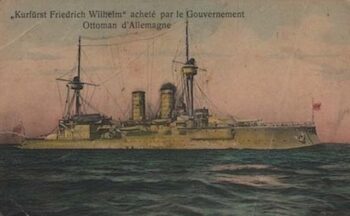
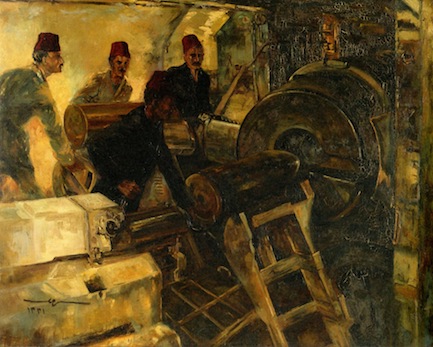
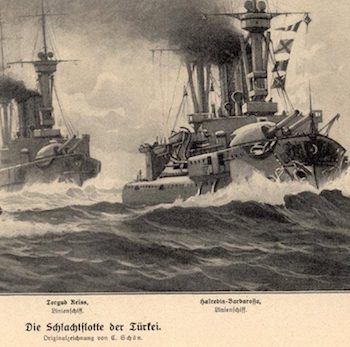
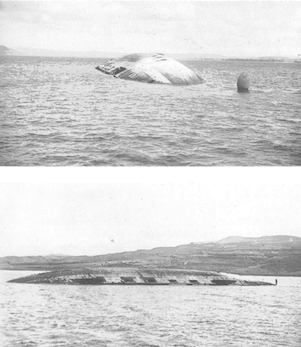
PAGE LAST UPDATED ON 25 FEBRUARY 2024